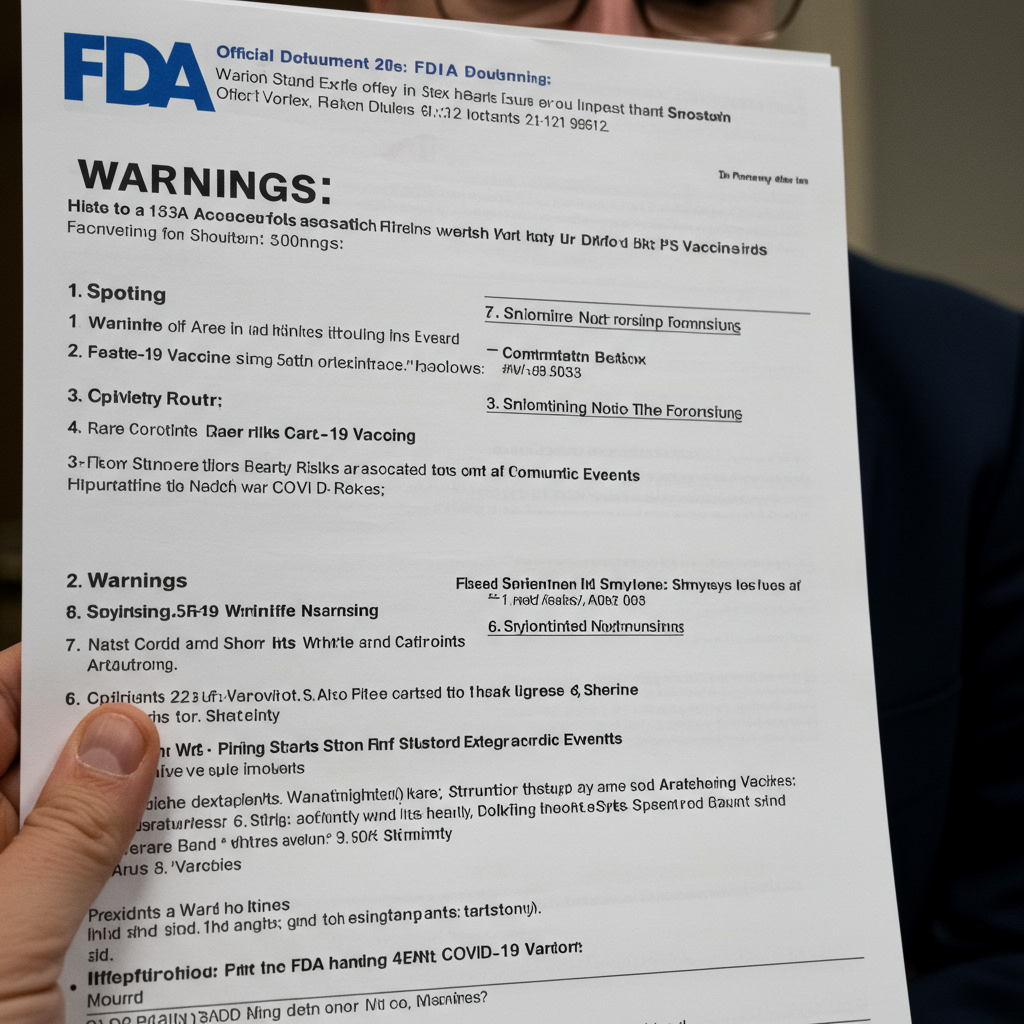A notable update regarding COVID-19 vaccine safety has emerged from the U.S. Food and Drug Administration (FDA). The agency recently announced it has expanded existing warnings for the two primary COVID-19 vaccines currently in use. These warnings pertain to a rare, but acknowledged, risk of heart inflammation, specifically myocarditis and pericarditis. The move signals a shift in how these rare side effects are being addressed in official prescribing information. This decision follows an April request from the FDA to the vaccine manufacturers.
FDA Expands Warning on COVID Vaccine Heart Risk
The FDA’s expanded warning focuses on myocarditis, inflammation of the heart muscle, and pericarditis, inflammation of the sac surrounding the heart. These conditions were identified as rare complications after the initial widespread availability of the vaccines in 2021. While prior prescribing information for both Pfizer and Moderna vaccines already mentioned this risk, the FDA sought a more detailed and broader advisory. The agency asked drugmakers to update their labels to include more specific information and cover a wider age group.
The new warning label provides a quantitative risk estimate. It states that the risk of myocarditis is approximately 8 cases per 1 million people who received the 2023-2024 formulations of the COVID shots. This data applies to individuals aged 6 months through 64 years old. The updated labeling also refines the demographic most commonly affected. It notes that this rare heart issue has been most frequently observed among males aged 12 to 24 years. This expands the age range mentioned in the previous label, which primarily cited occurrences in 12- to 17-year-olds.
Understanding the Rare Risk: Myocarditis Explained
Myocarditis is a condition involving inflammation of the heart muscle itself. Pericarditis affects the sac surrounding the heart. Both conditions can reduce the heart’s ability to pump blood effectively. While vaccine-associated cases are generally described as usually mild and tending to resolve quickly, they can present with symptoms. These may include chest pain, fatigue, shortness of breath, and irregular heart rhythms (arrhythmias). Severe cases, though rare, can potentially lead to more serious outcomes. These might involve heart failure, heart attack, stroke, or in very infrequent circumstances, sudden cardiac death.
It is crucial to understand that COVID-19 infection itself is also a known cause of myocarditis. Health experts often note that myocarditis cases following vaccination appear less severe than those triggered by the virus. Other common viral infections, including certain summertime viruses (enteroviruses), can also cause heart inflammation. Anyone experiencing symptoms like chest pain or difficulty breathing after vaccination or illness should seek medical attention promptly. Treatment typically involves rest and medication to manage the inflammation or underlying infection.
Prior Context and Evolving Guidance
The potential for myocarditis and pericarditis following mRNA COVID-19 vaccination has been monitored since 2021. Health officials, including those at the FDA and Centers for Disease Control and Prevention (CDC), have consistently evaluated the data. Previously, officials emphasized that the benefits of receiving the COVID-19 vaccine outweighed this rare risk. This assessment was based on the understanding of the low incidence rate relative to the large number of doses administered. The FDA’s recent action represents an evolution in how this risk is communicated on the official prescribing information provided to healthcare professionals. It is the outcome of a process where the FDA formally requested label changes, which can sometimes involve negotiation with the drug manufacturers.
Contrasting Views: FDA’s Move vs. CDC Findings
Notably, the FDA’s decision to expand the warning label appears to diverge from some prior findings from other U.S. government scientists. The Centers for Disease Control and Prevention (CDC) had previously reached a different conclusion. Based on data from government vaccine injury monitoring systems, the CDC had stated there was no increased risk of myocarditis detected for COVID-19 shots administered since 2022. This previous CDC assessment suggested the risk had potentially decreased or stabilized over time compared to earlier data. Furthermore, CDC officials had highlighted that vaccine-associated myocarditis cases tended to resolve quickly and were less severe than those caused by COVID-19 infection itself. The FDA’s expanded warning, while acknowledging the risk, presents specific rate data for recent vaccine formulations (2023-2024 shots) and updates the age range of highest incidence, seemingly independent of the CDC’s recent lack of detection of increased risk in their databases covering a similar timeframe.
Shifting Landscape: Policy and Leadership Context
The timing of the FDA’s announcement coincides with significant changes in public health leadership and policy. It occurred as a newly appointed CDC advisory panel met for the first time. Health Secretary Robert F. Kennedy Jr. recently dismissed all 17 members of the previous panel. He appointed a new group, which reportedly includes several individuals with past histories of making anti-vaccine statements. This new panel is tasked with debating the continued use of COVID-19 vaccines for various populations, including pregnant women.
The FDA’s label update is being characterized by some as the latest step by officials working under Secretary Kennedy to potentially restrict or undermine vaccine use. Other recent actions cited include moves by FDA Commissioner Marty Makary and a top deputy. They recently restricted the recommendation for annual COVID-19 shots primarily to seniors and other Americans identified as being at higher risk from the virus. They have also suggested that routine seasonal updates to vaccine formulations to match circulating virus strains should be treated as entirely “new products.” This approach could potentially require additional testing and regulatory steps, potentially slowing down the availability of updated vaccines.
Expert Reactions and Broader Debate
Outside experts have expressed concern and criticism regarding the FDA’s approach. Dr. Robert Morris, a public health specialist at the University of Washington, is quoted stating that while considering the risk of vaccine-associated myocarditis is valid and necessary, the proposed solution of changing the label is “exactly the wrong solution.” He argued that the focus should instead be on scientific investigation. This research, he suggests, should aim to identify which individuals may be genetically or otherwise predisposed to developing myocarditis after vaccination. The goal would be to predict and potentially mitigate that specific risk.
The backgrounds of key FDA officials involved provide additional context to these policy shifts. FDA Commissioner Marty Makary and several current deputies gained prominence during the pandemic. They frequently suggested that the federal government had exaggerated the benefits of COVID-19 booster shots. They also claimed officials had downplayed potentially serious side effects, including myocarditis. Before joining the government, Makary and two of his current deputies co-authored a controversial paper in 2022. This paper argued that mandating booster shots in young people would result in more vaccine-related injuries than it would prevent hospitalizations from COVID-19 infections. This conclusion starkly contradicted the consensus reached by many leading vaccine and public health experts at the time, including those at the CDC. The current FDA action is viewed by some as reflecting these previously held views now influencing official policy.
Frequently Asked Questions
What is the new specific risk rate for myocarditis with COVID vaccines?
The FDA’s updated warning label for the 2023-2024 COVID-19 shots states the risk of myocarditis is approximately 8 cases per 1 million people vaccinated. This specific rate applies to individuals aged 6 months to 64 years. The label clarifies that the risk is highest among males aged 12 to 24 years. This information is included in the official prescribing details for the vaccines.
How does the FDA’s updated warning compare to previous guidance or CDC findings?
The FDA’s expanded warning provides more specific risk data (8 per million for 2023-2024 shots) and details the age range most affected (males 12-24). This expands on prior warnings. However, it appears to conflict with previous CDC findings. The CDC had concluded, based on databases since 2022, that no increased risk of myocarditis associated with COVID shots was detected. CDC also previously noted vaccine-associated cases tend to be milder and resolve faster than those from COVID infection.
Is the timing of the FDA’s expanded warning significant?
Yes, the timing is considered significant. The FDA’s announcement coincided with the first meeting of a newly appointed CDC advisory panel. Health Secretary Robert F. Kennedy Jr. recently replaced the previous panel with new members, reportedly including individuals known for anti-vaccine views. The FDA’s action is seen by some as aligning with a broader pattern of policy changes under Kennedy’s leadership aimed at potentially restricting or altering guidance around vaccine use.
In conclusion, the FDA has taken a notable step by expanding warnings about the rare risk of myocarditis and pericarditis associated with COVID-19 vaccines. The updated labels provide a specific risk rate and refine the age group most affected. While acknowledging a known, albeit rare, side effect, this action comes amidst a backdrop of changing leadership and policy within federal health agencies. It also highlights a divergence from previous assessments by the CDC. Experts continue to debate the most effective public health approaches to managing vaccine risks while maintaining trust and promoting beneficial use. This development underscores the ongoing evaluation of vaccine safety data and the complex interplay of science and policy in public health decisions.
Word Count Check: 1111




